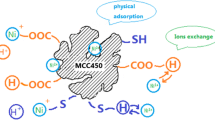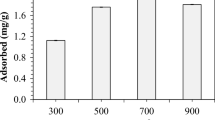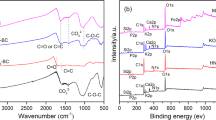Abstract
In this study, biochar was generated from chicken manure by using a tube furnace under different temperatures (300, 500, and 700 °C), and the treatments were noted as J300, J500, and J700, respectively. In comparison, another type of biochar was prepared under 500 °C with a muffle furnace, and the treatment was noted as JM500. Biochar in treatment group J500 was subsequently modified with HNO3 and NaOH, and the treatments were noted as J500-HNO3 and J500-NaOH, respectively. The sorption efficiencies of naphthalene by the above six types of biochar were evaluated. Characteristic results showed that the surface pores of the biochar were improved with the increase of temperature, and biochar under the treatments J300, J500, J700, and JM500 experienced a high speed of adsorption within 1 h after the naphthalene adsorption started. The adsorption capacity of naphthalene increased with the increase of the initial concentration of naphthalene. Treatment J700 exhibited the largest adsorption capacity since its biochar surface pore structure was more fully developed with a crystal structure formed, and its specific surface area was increased by about 20 times compared to the original chicken manure. After biochar modification using HNO3 and NaOH, the infrared spectrum changed, and the adsorption active sites were increased. The biochar modification by HNO3 had a high naphthalene adsorption efficiency compared to NaOH. The order of adsorption capacity was as follows: J500 ≈ JM500 < J300 < J500-NaOH < J500-HNO3 < J700.






Similar content being viewed by others
References
Alade AO (2012) Adsorption of naphthalene onto activated carbons derived from milk bush kernel shell and flamboyant pod. J Environ Chem Ecotoxicol 4:124–132. https://doi.org/10.5897/jece11.041
Chen B, Chen Z (2009) Sorption of naphthalene and 1-naphthol by biochars of orange peels with different pyrolytic temperatures. Chemosphere 76:127–133. https://doi.org/10.1016/j.chemosphere.2009.02.004
Chen B, Zhou D (2008) Transitional adsorption and partition of nonpolar and polar aromatic contaminants by biochars of pine needles with different pyrolytic temperatures. Environ Sci Technol 42:5137–5143
Dai Y, Niu J, Yin L, Xu J, Xu J (2013) Laccase-carrying electrospun fibrous membrane for the removal of polycyclic aromatic hydrocarbons from contaminated water. Sep Purif Technol 104:1–8. https://doi.org/10.1016/j.seppur.2012.11.013
Fernandes A, Rose M, Falandysz J (2017) Polychlorinated naphthalenes (PCNs) in food and humans. Environ Int 104:1–13. https://doi.org/10.1016/j.envint.2017.02.015
Freddo A, Cai C, Reid BJ (2012) Environmental contextualisation of potential toxic elements and polycyclic aromatic hydrocarbons in biochar. Environ Pollut 171:18–24. https://doi.org/10.1016/j.envpol.2012.07.009
Gómez J, Alcántara MT, Pazos M, Sanromán MA (2010) Remediation of polluted soil by a two-stage treatment system: desorption of phenanthrene in soil and electrochemical treatment to recover the extraction agent. J Hazard Mater 173:794–798. https://doi.org/10.1016/j.jhazmat.2009.08.103
Hale SE, Lehmann J, Rutherford D et al (2012) Quantifying the total and bioavailable polycyclic aromatic hydrocarbons and dioxins in biochars. Environ Sci Technol 46(5):2830–2838
Harmsen J, Rietra RPJJ (2018) 25 years monitoring of PAHs and petroleum hydrocarbons biodegradation in soil. Chemosphere 207:229–238. https://doi.org/10.1016/j.chemosphere.2018.05.043
Jin J, Li S, Peng X, Liu W, Zhang C, Yang Y, Han L, du Z, Sun K, Wang X (2018) HNO 3 modified biochars for uranium (VI) removal from aqueous solution. Bioresour Technol 256:247–253. https://doi.org/10.1016/j.biortech.2018.02.022
Kaur V, Sharma P (2019) Effect of Prosopis juliflora biochar on physico-chemical properties of naphthalene and phenanthrene contaminated soil. Polycycl Aromat Compd 0:1–12. https://doi.org/10.1080/10406638.2019.1678185
Keiluweit M, Nico PS, Johnson MG (2010) Dynamic molecular structure of plant biomass-derived black carbon (biochar). Environ Sci Technol 44:1247–1253
Kumar A, Gupta H (2020) Activated carbon from sawdust for naphthalene removal from contaminated water. Environ Technol Innov 20:101080. https://doi.org/10.1016/j.eti.2020.101080
Lamichhane S, Bal Krishna KC, Sarukkalige R (2016) Polycyclic aromatic hydrocarbons (PAHs) removal by sorption: a review. Chemosphere 148:336–353. https://doi.org/10.1016/j.chemosphere.2016.01.036
Leng RA (2014) Interactions between microbial consortia in biofilms : a paradigm shift in rumen microbial ecology and enteric methane mitigation. Anim Prod Sci 54:519–543
Li C, Zhu X, He H, Fang Y, Dong H, Lü J, Li J, Li Y (2019) Adsorption of two antibiotics on biochar prepared in air-containing atmosphere: influence of biochar porosity and molecular size of antibiotics. J Mol Liq 274:353–361. https://doi.org/10.1016/j.molliq.2018.10.142
Lin Q, Xu X, Chen Q et al (2017) The speciation, leachability and bioaccessibility of Cu and Zn in animal manure-derived biochar: effect of feedstock and pyrolysis temperature. Front Environ Sci Eng 11:1–12. https://doi.org/10.1007/s11783-017-0924-8
Liu J, Chen J, Jiang L, Yin X (2014) Adsorption of mixed polycyclic aromatic hydrocarbons in surfactant solutions by activated carbon. J Ind Eng Chem 20:616–623. https://doi.org/10.1016/j.jiec.2013.05.024
Liu Y, Xu Y, Huang Q, Qin X, Zhao L, Liang X, Wang L, Sun Y (2019) Effects of chicken manure application on cadmium and arsenic accumulation in rice grains under different water conditions. Environ Sci Pollut Res 26:30847–30856. https://doi.org/10.1007/s11356-019-06271-y
Luo J, Li X, Ge C, Müller K, Yu H, Huang P, Li J, Tsang DCW, Bolan NS, Rinklebe J, Wang H (2018) Sorption of norfloxacin, sulfamerazine and oxytetracycline by KOH-modified biochar under single and ternary systems. Bioresour Technol 263:385–392. https://doi.org/10.1016/j.biortech.2018.05.022
Meng Y, Liu X, Lu S, Zhang T, Jin B, Wang Q, Tang Z, Liu Y, Guo X, Zhou J, Xi B (2019) A review on occurrence and risk of polycyclic aromatic hydrocarbons (PAHs) in lakes of China. Sci Total Environ 651:2497–2506. https://doi.org/10.1016/j.scitotenv.2018.10.162
Mirbagheri AANS, Chen ZHP (2019) Efficient removal of naphthalene from aqueous solutions using a nanoporous kaolin/Fe3O4 composite. Int J Environ Sci Technol 17:1991–2002. https://doi.org/10.1007/s13762-019-02521-1
Mirheidari A, Torbatinejad NM, Shakeri P, Mokhtarpour A (2019) Effects of walnut shell and chicken manure biochar on in vitro fermentation and in vivo nutrient digestibility and performance of dairy ewes. Trop Anim Health Prod 51:2153–2160. https://doi.org/10.1007/s11250-019-01909-y
Mohan D, Sarswat A, Ok YS, Pittman CU (2014) Organic and inorganic contaminants removal from water with biochar, a renewable, low cost and sustainable adsorbent – a critical review. Bioresour Technol 160:191–202. https://doi.org/10.1016/j.biortech.2014.01.120
Mukherjee A, Zimmerman AR, Harris W (2011) Surface chemistry variations among a series of laboratory-produced biochars. Geoderma 163:247–255. https://doi.org/10.1016/j.geoderma.2011.04.021
Ncube S, Madikizela L, Cukrowska E, Chimuka L (2018) Recent advances in the adsorbents for isolation of polycyclic aromatic hydrocarbons (PAHs) from environmental sample solutions. Trends Anal Chem 99:101–116. https://doi.org/10.1016/j.trac.2017.12.007
Patra AK, Saxena J (2011) Exploitation of dietary tannins to improve rumen metabolism and ruminant nutrition. J Sci Food Agric 91:24–37. https://doi.org/10.1002/jsfa.4152
Peluffo M, Rosso JA, Morelli IS, Mora VC (2018) Strategies for oxidation of PAHs in aged contaminated soil by batch reactors. Ecotoxicol Environ Saf 151:76–82. https://doi.org/10.1016/j.ecoenv.2017.12.067
Prak DJL, Pritchard PH (2002) Solubilization of polycyclic aromatic hydrocarbon mixtures in micellar nonionic surfactant solutions. Water Res 36:3463–3472. https://doi.org/10.1016/S0043-1354(02)00070-2
Shi W, Guo Y, Ning G, Li C, Li Y, Ren Y, Zhao O, Yang Z (2018) Remediation of soil polluted with HMW-PAHs by alfalfa or brome in combination with fungi and starch. J Hazard Mater 360:115–121. https://doi.org/10.1016/j.jhazmat.2018.07.076
Tang L, Yu J, Pang Y et al (2017) Sustainable efficient adsorbent: alkali-acid modified magnetic biochar derived from sewage sludge for aqueous organiccontaminant removal. Chem Eng J 336:160–169
Thang PQ, Jitae K, Giang BL, Viet NM, Huong PT (2019) Potential application of chicken manure biochar towards toxic phenol and 2,4-dinitrophenol in wastewaters. J Environ Manag 251:109556. https://doi.org/10.1016/j.jenvman.2019.109556
Tian R, Li C, Xie S, You F, Cao Z, Xu Z, Yu G, Wang Y (2019) Preparation of biochar via pyrolysis at laboratory and pilot scales to remove antibiotics and immobilize heavy metals in livestock feces. J Soils Sediments 19:2891–2902. https://doi.org/10.1007/s11368-019-02350-2
Wang Z, Liu G, Zheng H, Li F, Ngo HH, Guo W, Liu C, Chen L, Xing B (2014) Investigating the mechanisms of biochar’s removal of lead from solution. Bioresour Technol 177:308–317. https://doi.org/10.1016/j.biortech.2014.11.077
Wei J, Tu C, Yuan G, Liu Y, Bi D, Xiao L, Lu J, Theng BKG, Wang H, Zhang L, Zhang X (2019) Assessing the effect of pyrolysis temperature on the molecular properties and copper sorption capacity of a halophyte biochar. Environ Pollut 251:56–65. https://doi.org/10.1016/j.envpol.2019.04.128
Wu M, Pan B, Zhang D, Xiao D, Li H, Wang C, Ning P (2013) The sorption of organic contaminants on biochars derived from sediments with high organic carbon content. Chemosphere 90:782–788. https://doi.org/10.1016/j.chemosphere.2012.09.075
Xu D, Cao J, Li Y, Howard A, Yu K (2019) Effect of pyrolysis temperature on characteristics of biochars derived from different feedstocks: a case study on ammonium adsorption capacity. Waste Manag 87:652–660. https://doi.org/10.1016/j.wasman.2019.02.049
Yao Y, Gao B, Chen H, Jiang L, Inyang M, Zimmerman AR, Cao X, Yang L, Xue Y, Li H (2012) Adsorption of sulfamethoxazole on biochar and its impact on reclaimed water irrigation. J Hazard Mater 209–210:408–413. https://doi.org/10.1016/j.jhazmat.2012.01.046
Yargicoglu EN, Yamini B, Reddy KR, Spokas K (2014) Physical and chemical characterization of waste wood derived biochars. Waste Manag 36:256–268. https://doi.org/10.1016/j.wasman.2014.10.029
Yin Z, Liu Y, Liu S, Jiang L, Tan X, Zeng G, Li M, Liu S, Tian S, Fang Y (2018) Activated magnetic biochar by one-step synthesis: enhanced adsorption and coadsorption for 17β-estradiol and copper. Sci Total Environ 639:1530–1542. https://doi.org/10.1016/j.scitotenv.2018.05.130
Yin Z, Liu Y, Tan X, Jiang L, Zeng G, Liu S, Tian S, Liu S, Liu N, Li M (2019) Adsorption of 17Β-estradiol by a novel attapulgite/biochar nanocomposite: characteristics and influencing factors. Process Saf Environ Prot 121:155–164. https://doi.org/10.1016/j.psep.2018.10.022
Zeng AX, Xiao Z, Zhang G (2018) SC. Elsevier B.V.
Zhang ZL, Hong HS, Zhou JL, Yu G (2004) Phase association of polycyclic aromatic hydrocarbons in the Minjiang River Estuary, China. Sci Total Environ 323:71–86. https://doi.org/10.1016/j.scitotenv.2003.09.026
Zheng H, Wang Z, Deng X, Zhao J, Luo Y, Novak J, Herbert S, Xing B (2013a) Characteristics and nutrient values of biochars produced from giant reed at different temperatures. Bioresour Technol 130:463–471. https://doi.org/10.1016/j.biortech.2012.12.044
Zheng H, Wang Z, Zhao J, Herbert S, Xing B (2013b) Sorption of antibiotic sulfamethoxazole varies with biochars produced at different temperatures. Environ Pollut 181:60–67. https://doi.org/10.1016/j.envpol.2013.05.056
Zhou W, Wang X, Chen C, Zhu L (2013) Removal of polycyclic aromatic hydrocarbons from surfactant solutions by selective sorption with organo-bentonite. Chem Eng J 233:251–257. https://doi.org/10.1016/j.cej.2013.08.040
Zhu L, Li S, Hu T, Nugroho YK, Yin Z, Hu D, Chu R, Mo F, Liu C, Hiltunen E (2019) Effects of nitrogen source heterogeneity on nutrient removal and biodiesel production of mono- and mix-cultured microalgae. Energy Conversion and Management 201:112144
Acknowledgments
This work was financially supported by National Key R&D Program of China (2019YFC1803405; 2019YFD1101300).
Author information
Authors and Affiliations
Contributions
C.L. and Z.Y. designed and did the experiments, while D.H., F.M., and R.C. helped during the experiments. L.Z. and C.H. supervised the work.
Corresponding authors
Ethics declarations
This paper is our unpublished work and it has not been submitted to any other journal for reviews. Thus, it has not been previously published, in whole or in part, and it is not under consideration by any other journal.
Consent to publish
All authors are aware of, and accept responsibility for, the manuscript.
Conflict of interest
The authors declare that they have no conflict of interest.
Additional information
Responsible Editor: Zhihong Xu
Publisher’s note
Springer Nature remains neutral with regard to jurisdictional claims in published maps and institutional affiliations.
Rights and permissions
About this article
Cite this article
Liu, C., Yin, Z., Hu, D. et al. Biochar derived from chicken manure as a green adsorbent for naphthalene removal. Environ Sci Pollut Res 28, 36585–36597 (2021). https://doi.org/10.1007/s11356-021-13286-x
Received:
Accepted:
Published:
Issue Date:
DOI: https://doi.org/10.1007/s11356-021-13286-x




